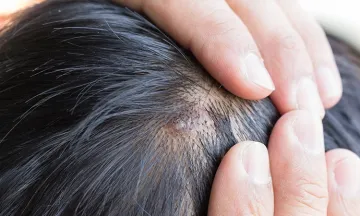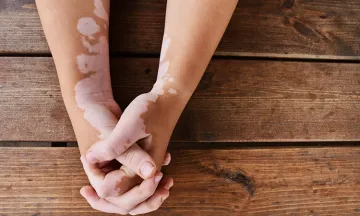Lichen Planus: Know About its Symptoms and Types
Lichen Planus. Have you even heard of something by this name? Just imagine -Your skin is getting worse day-by-day with dark and raised lesions appearing on it. You go to a doctor who diagnoses your condition as lichen planus. You haven’t even heard of it before and now you are suffering from it! We understand that it is emotionally depressing to suffer from any skin condition and more so if you are suffering from something you have no clue about. This post will help you know more about this skin ailment called lichen planus, its symptoms and different variants. Knowing about your skin condition might help you to know the treatment your disorder will respond well to. Also, read our blog on causes and treatment of lichen planus.
Lichen planus is a chronic inflammatory condition that affects the skin, mouth and genitals. It is characterised by rows or clusters of dark, raised, flat-topped skin lesions. The definite cause of this disorder is unknown but it is thought to be related to immunity and allergic reaction.
Lichen planus is neither infectious nor contagious in nature. Apart from being chronic, the disease has periods of remissions (when the symptoms disappear or reduce in intensity) and relapses (when the disease symptoms increase in intensity). Hence, patient compliance to conventional treatment is poor at times.
The disease can affect people of any age group, though it tends to be common in young adults and middle ages. However, children and old people can also be affected by this disease. Lichen planus affects females more commonly as compared to males.
Symptoms of lichen planus
Lichen planus can be easily identified in most cases because of the typical location of rashes and their 'violaceous' appearance. The skin eruptions of lichen planus tend to involve the following areas:
- Insides of the wrists
- Ankles
- Lower back
- Scalp
- Nails
- Mucous membranes that line the mouth. nose, genitals (vagina / penis) and anus
Lichen planus affects oral cavity (50%), body areas (20%), vulva or penis (10%), scalp (10%) and nails (10%).
The onset of eruptions can be sudden or gradual, and they show the following features:
- rows or small clusters of flat-topped eruptions, usually a few millimeters in diameter;
- violet colour of rashes in most cases; the colour may vary from purple to pink to red;
- itching, which may vary from mild to severe;
- new eruptions may appear at the sites of minor skin injury, such as a superficial scratch (called as Koebner's phenomenon);
- in some cases, there may be thick, reddish-brown lesions that are covered with scales (called as hypertrophic lichen planus);
- when the rashes resolve, they leave behind dark brown or grey spots (hyperpigmentation marks);
- in cases of scalp involvement, there can be a development of scarring in the affected areas, leading to loss of hair; and
- affected nails may develop pits and grooves.
Oral lichen planus has a typical presentation that involves the following:
- small, pale, raised areas that form a lacy network on the inside of the cheeks, rarely involving the tongue (occasionally, the lesions may be red and shiny);
- soreness, burning pain, tenderness, especially while having spicy foods;
- dry mouth with metallic taste or blunted-taste sensation; and
- painful, recurrent ulcers in the mouth.
People with long-term lesions of oral lichen planus are at a greater risk of developing malignancy (squamous cell carcinoma).
Variants of lichen planus
Lichen planus may occur differently in different individuals. Certain variants respond better to treatment, whereas others tend to be more obstinate. Depending on the presentation of the lesions (and their peculiar locations), described below are some types of lichen planus:
-
hypertrophic lichen planus (lichen planus verrucosus) — thickened lesions of lichen planus, usually seen on the extremities, especially the shin. It tends to be very itchy in nature;
-
follicular lichen planus (or lichen planopilaris) — hair follicles get affected, which further leads to scarring. There is hair loss in the affected parts;
-
lichen planus actinicus (actinic lichen planus) — common in Middle Eastern countries and India in the summers. Exposed areas of the face, dorsum of the hands, arms and nape of the neck develop dark, lesions, with pale borders;
-
lichen planus pigmentosus — another variant common in India, where dark-brown spots develop in sun-exposed areas and folds of the skin, and spread to the upper body;
-
annular lichen planus — commonly involves the male genitalia, but also has a predilection for folds of the skin, such as the axilla and groin folds, marked by small clusters of lesions in a ring form; and
-
linear lichen planus — lesions develop along a straight line, usually on the extremities. They may develop secondary to trauma or itching (the Koebner's phenomenon).
Apart from these, there are other rare types of lichen planus such as bullous, ulcerative and atrophic lichen planus.
Homeopathic treatment for lichen planus is effective and without any side-effects. Homeopathic medicines for lichen planus target the altered immunity of the body and bring it back to normalcy over a period of time. Treatment helps in the resolution of existing lesions, reduces itching and controls the further spread of lesions. Unlike conventional treatment (which includes steroids), the homeopathic treatment for lichen planus tends to give lasting relief to the patients. Homeopathic medicines for lichen planus are also safe and non-habit forming. Read more about the homeopathic treatment of lichen planus.




